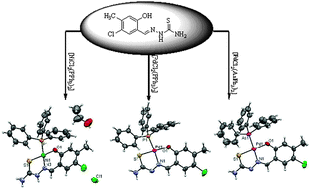New complexes, [Ni(HL)(PPh3)]Cl (1), [Pd(L)(PPh3)](2), and [Pd(L)(AsPh3)](3), were synthesized from the reactions of 4-chloro-5-methyl-salicylaldehyde thiosemicarbazone [H2L] with [NiCl2(PPh3)2], [PdCl2(PPh3)2] and [PdCl2(AsPh3)2]. They were characterized by IR, electronic, 1H-NMR spectral data. Further, the structures of the complexes have been determined by single crystal X-ray diffraction. While the thiosemicarbazone coordinated as binegative tridentate (ONS) in complexes 2 and 3, it is coordinated as mono negative tridentate (ONS) in 1. The interactions of the new complexes with calf thymus DNA was examined by absorption and emission spectra, and viscosity measurements. Moreover, the antioxidant properties of the new complexes have also been tested against DPPH radical in which complex 1 exhibited better activity than that of the other two complexes 2 and 3. The in vitro cytotoxicity of complexes 1–3 against A549 and HepG2 cell lines was assayed, and the new complexes exhibited higher cytotoxic activity with lower IC50 values indicating their efficiency in killing the cancer cells even at very low concentrations.

You have access to this article
 Please wait while we load your content...
Something went wrong. Try again?
Please wait while we load your content...
Something went wrong. Try again?


 Please wait while we load your content...
Please wait while we load your content...